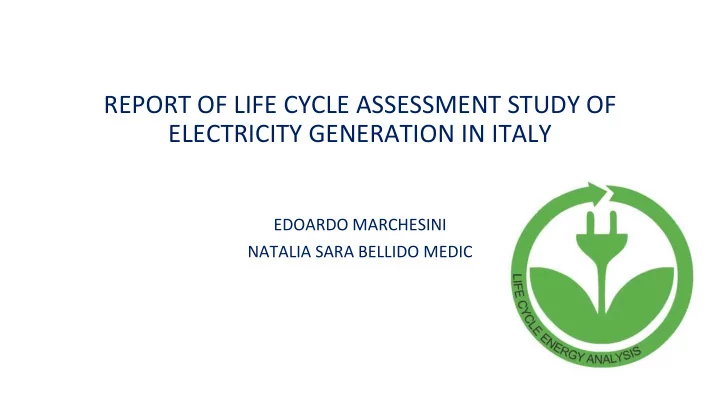

REPORT OF LIFE CYCLE ASSESSMENT STUDY OF ELECTRICITY GENERATION IN ITALY EDOARDO MARCHESINI NATALIA SARA BELLIDO MEDIC
SUMMARY • Pie chart of electricity production • Situation of nuclear power • GWP • FAETP • Conclusion
PIE CHART OF SELECTED CRITERIA CML2001 KIND OF POWER PERCENTAGE POWER BIOGAS 1,7 BIOMASS SOLID 0,75 COAL GASES 1,56 GEO THERMAL 1, 78 HARD COAL 12,93 HEAVY FUEL OIL 7,21 HYDRO 18,06 LIGNITE 0,26 NATURAL GAS 50,7 PHOTOVOLTAICS 0,63 WASTE 3,03 WIND 1,39
ENERGY NOT CONSIDERED IN THE PIE CHART Grid losses (transport and distribution losses): the amounts of energy that are not paid for by users. The difference between what be generated and what be distributed. OWN CONSUMPTION 1,56 T&D Losses = (Energy Input to feeder (Kwh) – Billed Energy to Consumer (Kwh)) / Energy Input kwh x 100 GRID LOSSES 6,22 Own consumption : the total energy needed from the power plants to run up the electricity necessary for the consumers. All together, grid losses, own consumption and the energy of the different technologies made the energy produced by the country.
NUCLEAR POWER From 1966, 4 nuclear power plants 1 ° referendum, 1987 to abolish the use of nuclear power plants 2 ° referendum, 2011 to reintroduce nuclear Map of nuclear plants in Italy in 1987
GLOBAL WARMING POTENTIAL CML2001 - Apr. 2013, Global Warming Potential, excl biogenic carbon (GWP 100 years) [kg CO2-Equiv.] 1,400 1,149 1,200 1,092 1,085 1,056 1,000 0,839 0,800 0,600 0,524 0,524 0,450 0,401 0,400 0,200 0,069 0,063 0,035 0,013 0,007 0,000 EU-27: IT: Electricity biogas biomass coal gases geothermal hard coal heavy fuel oil hydro power lignite natural gas photovoltaic waste wind power Electricity grid grid mix PE (HFO) mix 1kV-60kV PE • Biogenic CO2 emissions are defined as “non - fossilized and biodegradable organic material originating from plants, animals, or microorganisms “ • Biogas from 0,207 to 0,401 • GWPs have the highest technologies based on carbon dioxide, methane and CFCs: coal gasses, hard coal, HOF, lignite, natural gas and waste. T
FRESHWATER AQUATIC ECOTOXICITY POTENTIAL Figure: Freshwater Eco Toxicity (FAETP) for the production of 1 kWh of electricity for different technologies in Italy. -Industries produce large amount of materials and energy that negatively influence water. -Industries warm water . - Crops for use as biomass-- > in areas dedicated to irrigation, problems of water pollution can also arise as a result of soil and nutrient runoff (eutrophication of the water) . -And if we talk about the industrial discharge we have to say that 25 percent of Italy's wastewater flows into the sea, lakes and rivers without proper purificatio n.
CONCLUSION • Sustainable development is vita l for the evolution of generations, and the energy sector, having a major contribution to it, should be effectively assessed and managed to accomplish the fruits of sustainable electricity production. • Comparing the individual sources of electricity generation with respect to considered sustainability indicators, hydropowe r is the most preferred source due to the lowest environmental impacts. It is further revealed that heavy fuel oil is the worst option for capital investment in Italy. • Overall in five environmental indicators, heavy fuel oil , biogas and biomass is the worst option for electricity generation and is advisable to minimize this kind of sources in energy mixes. • Hydropower, wind power and geothermal technology impose the least impact on economic and environmental concerns, and thus should be positively included in the future energy mixes
Recommend
More recommend